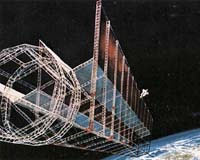The main source of energy for humankind is still fossil fuels, or hydrocarbons (oil, gas and coal). Their use, however, has a markedly adverse effect on the environment, not to mention their scarcity. Nuclear power and renewable energy sources (hydro, tidal, geothermal and wind-driven power plants) offer a partial solution. But even they do not address the issue of transport, which uses mostly liquid hydrocarbons. In short, the world has not yet come up with an engineering solution to these energy and environmental problems. Under the circumstances, tapping space for energy may be the best way out.
The Sun is the original source of all energy on this planet. It helped the Earth to accumulate the hydrocarbon reserves which we are now burning away. For the human race to be able to meet its energy requirements, it requires 10 billion tons of fuel equivalent a year. The energy that annually reaches the Earth from the Sun is equivalent to 100 trillion tons of fuel equivalent. By exploiting just one per cent of that amount, i.e. one trillion tons, humanity could solve many of its problems for centuries ahead.
The simplest way to convert solar radiation into electricity is by using the so-called extrinsic photo effect, whereby particles of light "knock out" electrons from a screen put up in their path. Soviet scientists from the Leningrad Physical and Technical Institute were the first to produce an electric current in that fashion in the 1930s. True, the efficiency of the first solar sulfur-helium elements was barely 1%. But starting in 1958, silicon solar batteries became the main source of electric power on spacecraft. By the mid-1970s, their efficiency approached 10%, where it remained for nearly two decades. It was only in the mid-1990s that it went up to 15%, and, by the turn of the new century, it had reached 20%.
This was achieved mainly by improving the technique for producing pure silicon - the basic material for making solar cells - from quartzites. The largest deposits of very pure quartzites are found in Russia, which had vast reserves of them. Recently the Joint Institute for Nuclear Research in Dubna, near Moscow, developed a photo cell with an efficiency of almost 50%. Scientists describe their product as a "star battery." It is an example of how nanotechnology can improve the workings of well-known processes.
They embedded tiny particles of gold into a silicon wafer only 0.5 mm thick. The properties of the material changed so dramatically that while in ordinary cells one electron needs 5 to 6 light photons to be knocked out, in this case it is enough to have two, and it is possible that in the future only one will be required. In practice this means that 1 square meter of solar battery surface can yield 600 watts and later perhaps even 1 kW of electricity. Unlike normal silicon, the new material is sensitive to a wide range of solar radiation, from the ultraviolet to the infrared spectrums.
The Dubna researchers also made a supercapacitor using the same material. A cylinder 3 sm in diameter can store 900 times more power than that contained in a normal car battery. This is important because solar batteries function only during the day, but power is needed round the clock, so enough must be stored for the night.
The first commercial solar power plant was built in 1985 in the U.S.S.R., not far from Shchelkino in the Crimea. It had a peak capacity of 5 MW - as much as the first nuclear reactor. But in the mid-1990s the plant was closed down because its electricity generating costs proved too high, partly because of the low operating efficiency of solar cells on Earth. It was therefore decided to build solar power plants in space.
The idea was first discussed at the Soviet Academy of Sciences soon after Yury Gagarin's pioneering space flight and was found to be worthwhile. In the years that followed, projects for space-based solar plants multiplied like rabbits, especially during the energy crisis of the mid-1970s. But all of them were "hooked" to the geostationary orbit, which was almost filled to capacity with information satellites from many countries. Power plants, if inserted into orbit, could prove a big nuisance for them.
A preferable orbit would be the extended 12-hour sun-synchronous one, or one with similar properties. In that case, the power plant would appear above the horizon twice a day. Its furthest point would be above the North Pole at an altitude of 40,000 kilometers, and at its closest it would come within 500 kilometers of the Earth's surface above the South Pole. One such plant would send power during the 8 hours when it is nearest to the Earth, mostly to the northern regions of the country that are in most need of it. During the remaining 4 hours, storage plants would accumulate power for future needs.
To deliver parts to working orbits, assemble them there and later perform maintenance on the plants, assembly, aerospace and inter-orbit transports systems will have to be developed, which is just as challenging as building the plants themselves. But whatever way you look at them, solar plants in space are a better and less costly option for energy problems on the Earth than flying to the Moon to fetch helium-3 for fusion reactors.

